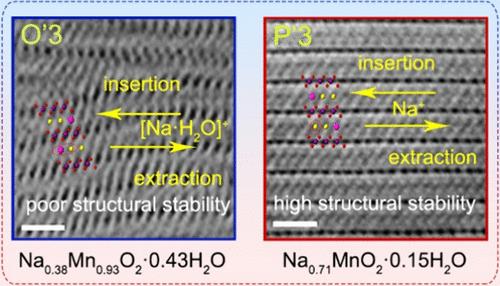通过 P′3-堆叠技术将高纳含量桦木岩与可调谐活性面相结合,用于先进的钠离子水电池
IF 15.8
1区 材料科学
Q1 CHEMISTRY, MULTIDISCIPLINARY
引用次数: 0
摘要
层状 Na-birnessites 具有理论容量高、成本低和对环境无害等优点,是一种很有前途的水性钠离子电池阴极材料。然而,一般的 O′3 钠桦烷石的钠含量较低,且主要存在不活泼的{001}裸露面,这影响了其钠储存能力和循环稳定性。在此,我们通过水热转化方法开发出了一种具有高度富集{010}活性面的高纳含量 P′3-Na0.71MnO2-0.15H2O 。与 O′3 Na-birnessite 相比,具有高比例{010}/{001}裸露面的 P′3 Na-birnessite 大大增加了 Na+ 扩散的开放通道,而 P′3 堆叠则降低了 Na+ 扩散阻力,从而改善了电极动力学,在 0.2 A g-1 条件下可获得 176 mAh g-1 的大比容量。更重要的是,P′3 Na-birnessite 在水性电解质中表现出独特的 Na+ 插层/脱插层能力和非凡的循环稳定性,在 60,000 次循环后可达到 90.5% 的容量保持率。与 NaTi2(PO4)3 阳极配合使用时,基于 P′3 Na-birnessite 的全电池可实现高能量密度和长循环寿命,证明了其在水性钠离子电池中的应用潜力。这项研究展示了制备具有可调暴露面的高纳含量 P′3 比尔内斯特的有效方法,并为开发用于可持续水性钠离子电池的高稳定性层状阴极提供了重要启示。本文章由计算机程序翻译,如有差异,请以英文原文为准。

High-Na-Content Birnessite via P′3-Stacking with Tunable Active Facets for Advanced Aqueous Sodium-Ion Batteries
Layered Na-birnessites are promising cathode materials for aqueous sodium-ion batteries due to their high theoretical capacity, low cost, and environmental benignity. However, the general O′3 Na-birnessites possess low Na content and dominant inactive {001} exposed facets, which compromise their Na storage capability and cycling stability. Herein, we develop a high-Na-content P′3-Na0.71MnO2·0.15H2O with highly enriched {010} active facets by a hydrothermal conversion method. In comparison with the O′3 Na-birnessite, the P′3 Na-birnessite with a high ratio of {010}/{001} exposed facets provides greatly increased open channels for Na+ diffusion, while the P′3 stacking affords a lower Na+ diffusion barrier, resulting in improved electrode kinetics with a large specific capacity of 176 mAh g–1 at 0.2 A g–1. More importantly, the P′3 Na-birnessite manifests solo Na+ intercalation/deintercalation with extraordinary cycling stability in an aqueous electrolyte, achieving 90.5% capacity retention after 60,000 cycles. When coupled with the NaTi2(PO4)3 anode, the P′3 Na-birnessite-based full cell delivers both high energy density and long cycle life, demonstrating the potential application in aqueous sodium-ion batteries. This study demonstrates an efficient method to prepare high-Na-content P′3 birnessite with tunable exposed facets and provides important insights into developing highly stable layered cathodes for sustainable aqueous sodium-ion batteries.
求助全文
通过发布文献求助,成功后即可免费获取论文全文。
去求助
来源期刊

ACS Nano
工程技术-材料科学:综合
CiteScore
26.00
自引率
4.10%
发文量
1627
审稿时长
1.7 months
期刊介绍:
ACS Nano, published monthly, serves as an international forum for comprehensive articles on nanoscience and nanotechnology research at the intersections of chemistry, biology, materials science, physics, and engineering. The journal fosters communication among scientists in these communities, facilitating collaboration, new research opportunities, and advancements through discoveries. ACS Nano covers synthesis, assembly, characterization, theory, and simulation of nanostructures, nanobiotechnology, nanofabrication, methods and tools for nanoscience and nanotechnology, and self- and directed-assembly. Alongside original research articles, it offers thorough reviews, perspectives on cutting-edge research, and discussions envisioning the future of nanoscience and nanotechnology.
 求助内容:
求助内容: 应助结果提醒方式:
应助结果提醒方式:


